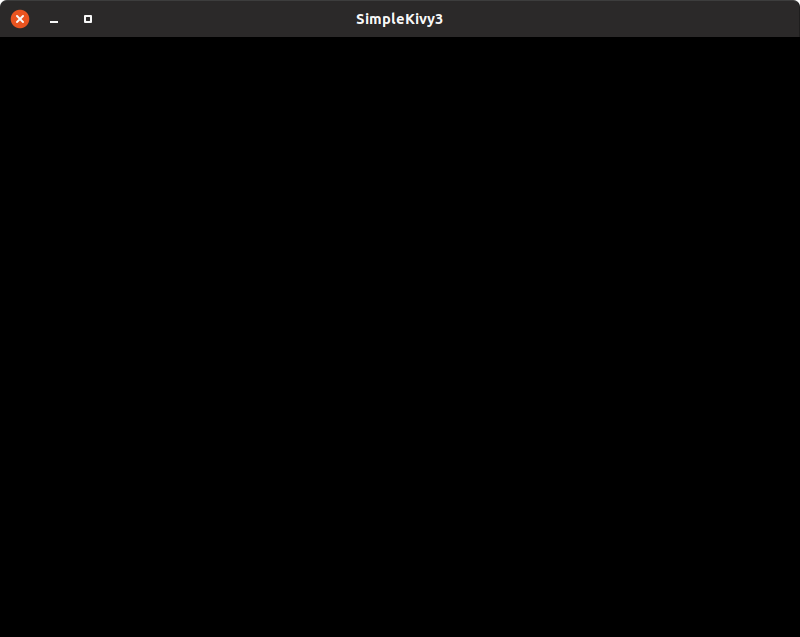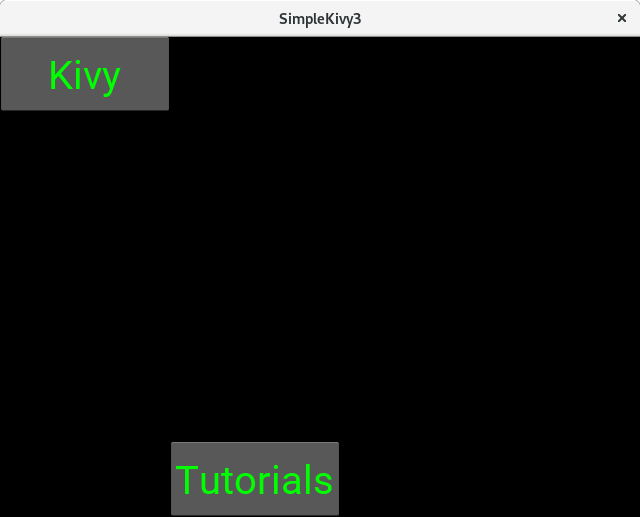Use Kivy’s .kv files correctly and import them into your Python scripts
I’m following tutorials for Kivy and I can’t load attributes properly from .kv files. For some reason, I can sometimes pull .kv files by for kv in listdir(kv_path): Builder.load_file(kv_path+kv), but I can’t do this by simply putting the kv file in the same root and letting it “import itself?” ”
For example, when using files:
Master .py
from kivy.app import App
from kivy.uix.label import Label
from kivy.uix.widget import Widget
class Widgets(Widget):
pass
class SimpleKivy3(App):
def build(self):
return Widgets()
if __name__ == "__main__":
SimpleKivy3().run()
SimpleKivy3.kv
<Button>:
font_size: 40
size: 170,75
color: 0,1,0,1
<Widgets>:
Button:
pos: root.x, root.top - self.height
text: "Kivy"
Button:
pos: 170,0
text: "Tutorials"
I get the following output on my terminal:
$ python main.py
[INFO ] [Logger ] Record log in /home/nickshu/.kivy/logs/kivy_18-09-12_58.txt
[INFO ] [Kivy ] v1.11.0.dev0, git-038acbf, 20180912
[INFO ] [Python ] v3.6.5 | Anaconda, Inc.| (default, Apr 29 2018, 16:14:56)
[GCC 7.2.0]
[INFO ] [Factory ] 195 symbols loaded
[INFO ] [Image ] Providers: img_tex, img_dds, img_sdl2, img_pil, img_gif (img_ffpyplayer ignored)
[INFO ] [Text ] Provider: sdl2
[INFO ] [Window ] Provider: sdl2(['window_egl_rpi'] ignored)
[INFO ] [GL ] Using the "OpenGL" graphics system
[INFO ] [GL ] Backend used <gl>
[INFO ] [GL ] OpenGL version <b'3.0 Mesa 18.0.5'>
[INFO ] [GL ] OpenGL vendor <b'Intel Open Source Technology Center'>
[INFO ] [GL ] OpenGL renderer <b'Mesa DRI Intel(R) HD Graphics P630 (Kaby Lake GT2) '>
[INFO ] [GL ] OpenGL parsed version: 3, 0
[INFO ] [GL ] Shading version <b'1.30'>
[INFO ] [GL ] Texture max size <16384>
[INFO ] [GL ] Texture max units <32>
[INFO ] [Window ] auto add sdl2 input provider
[INFO ] [Window ] virtual keyboard not allowed, single mode, not docked
[INFO ] [ProbeSysfs ] device match: /dev/input/event6
[INFO ] [MTD ] Read event from </dev/input/event6>
[INFO ] [Base ] Start application main loop
[INFO ] [MTD ] </dev/input/event6> range position X is 1266 - 5676
[INFO ] [MTD ] </dev/input/event6> range position Y is 1094 - 4762
[INFO ] [MTD ] </dev/input/event6> range touch major is 0 - 0
[INFO ] [MTD ] </dev/input/event6> range touch minor is 0 - 0
[INFO ] [MTD ] </dev/input/event6> range pressure is 0 - 255
[INFO ] [MTD ] </dev/input/event6> axes invertion: X is 0, Y is 0
[INFO ] [MTD ] </dev/input/event6> rotation set to 0
The window below is displayed!

Does anyone know what I’m doing wrong? These are my permissions for /dev/input/event6
crwxrwxr-- 1 root input 13, 70 Sep 11 23:47/dev/input/event6
Thank you very much!
Solution
According to docs you have two possibilities:
1.
By name convention:
Kivy looks for a Kv file with the same name as your App class in lowercase, minus “App” if it ends with ‘App’ e.g:
MyApp -> my.kv
If this file defines a Root Widget it will be attached to the App’s root attribute and used as the base of the application widget tree.
So you have to change the .kv name to lowercase and the name of the class app to end with the app:
simplekivy3.kv
<Button>:
font_size: 40
size: 170,75
color: 0,1,0,1
<Widgets>:
Button:
pos: root.x, root.top - self.height
text: "Kivy"
Button:
pos: 170,0
text: "Tutorials"
*.py
from kivy.app import App
from kivy.uix.widget import Widget
class Widgets(Widget):
pass
class SimpleKivy3App(App):
def build(self):
return Widgets()
if __name__ == "__main__":
SimpleKivy3App().run()
2.
Builder: You can tell Kivy to directly load a string or a file. If
this string or file defines a root widget, it will be returned by the
method:Builder.load_file(‘path/to/file.kv’)
from kivy.app import App
from kivy.uix.widget import Widget
from kivy.lang import Builder
class Widgets(Widget):
pass
Builder.load_file('SimpleKivy3.kv')
class SimpleKivy3(App):
def build(self):
return Widgets()
if __name__ == "__main__":
SimpleKivy3().run()

